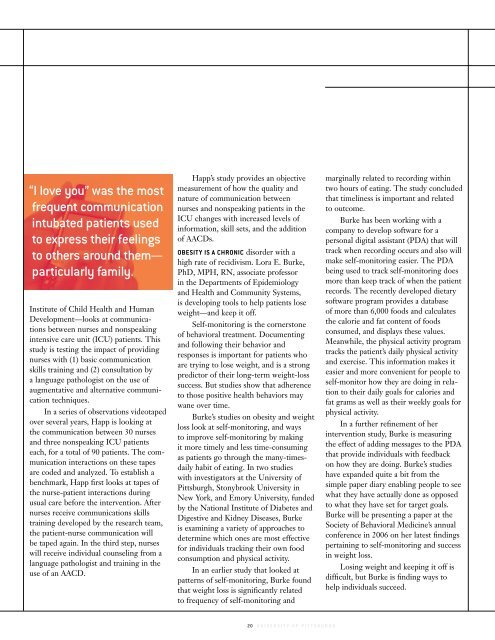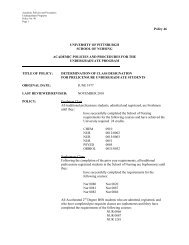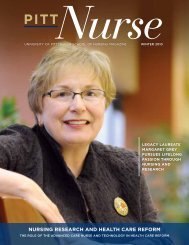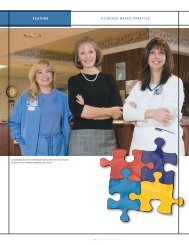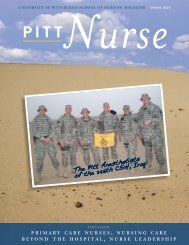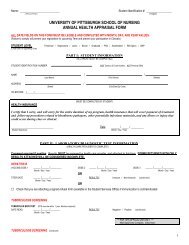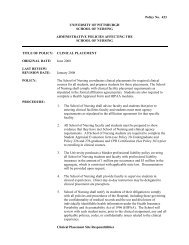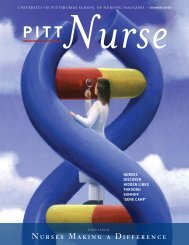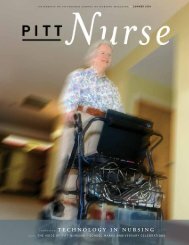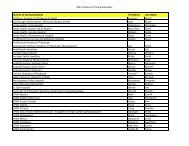complete issue - School of Nursing - University of Pittsburgh
complete issue - School of Nursing - University of Pittsburgh
complete issue - School of Nursing - University of Pittsburgh
Create successful ePaper yourself
Turn your PDF publications into a flip-book with our unique Google optimized e-Paper software.
“I love you” was the mostfrequent communicationintubated patients usedto express their feelingsto others around them—particularly family.Institute <strong>of</strong> Child Health and HumanDevelopment—looks at communicationsbetween nurses and nonspeakingintensive care unit (ICU) patients. Thisstudy is testing the impact <strong>of</strong> providingnurses with (1) basic communicationskills training and (2) consultation bya language pathologist on the use <strong>of</strong>augmentative and alternative communicationtechniques.In a series <strong>of</strong> observations videotapedover several years, Happ is looking atthe communication between 30 nursesand three nonspeaking ICU patientseach, for a total <strong>of</strong> 90 patients. The communicationinteractions on these tapesare coded and analyzed. To establish abenchmark, Happ first looks at tapes <strong>of</strong>the nurse-patient interactions duringusual care before the intervention. Afternurses receive communications skillstraining developed by the research team,the patient-nurse communication willbe taped again. In the third step, nurseswill receive individual counseling from alanguage pathologist and training in theuse <strong>of</strong> an AACD.Happ’s study provides an objectivemeasurement <strong>of</strong> how the quality andnature <strong>of</strong> communication betweennurses and nonspeaking patients in theICU changes with increased levels <strong>of</strong>information, skill sets, and the addition<strong>of</strong> AACDs.Obesit y is a chronic disorder with ahigh rate <strong>of</strong> recidivism. Lora E. Burke,PhD, MPH, RN, associate pr<strong>of</strong>essorin the Departments <strong>of</strong> Epidemiologyand Health and Community Systems,is developing tools to help patients loseweight—and keep it <strong>of</strong>f.Self-monitoring is the cornerstone<strong>of</strong> behavioral treatment. Documentingand following their behavior andresponses is important for patients whoare trying to lose weight, and is a strongpredictor <strong>of</strong> their long-term weight-losssuccess. But studies show that adherenceto those positive health behaviors maywane over time.Burke’s studies on obesity and weightloss look at self-monitoring, and waysto improve self-monitoring by makingit more timely and less time-consumingas patients go through the many-timesdailyhabit <strong>of</strong> eating. In two studieswith investigators at the <strong>University</strong> <strong>of</strong><strong>Pittsburgh</strong>, Stonybrook <strong>University</strong> inNew York, and Emory <strong>University</strong>, fundedby the National Institute <strong>of</strong> Diabetes andDigestive and Kidney Diseases, Burkeis examining a variety <strong>of</strong> approaches todetermine which ones are most effectivefor individuals tracking their own foodconsumption and physical activity.In an earlier study that looked atpatterns <strong>of</strong> self-monitoring, Burke foundthat weight loss is significantly relatedto frequency <strong>of</strong> self-monitoring andmarginally related to recording withintwo hours <strong>of</strong> eating. The study concludedthat timeliness is important and relatedto outcome.Burke has been working with acompany to develop s<strong>of</strong>tware for apersonal digital assistant (PDA) that willtrack when recording occurs and also willmake self-monitoring easier. The PDAbeing used to track self-monitoring doesmore than keep track <strong>of</strong> when the patientrecords. The recently developed dietarys<strong>of</strong>tware program provides a database<strong>of</strong> more than 6,000 foods and calculatesthe calorie and fat content <strong>of</strong> foodsconsumed, and displays these values.Meanwhile, the physical activity programtracks the patient’s daily physical activityand exercise. This information makes iteasier and more convenient for people toself-monitor how they are doing in relationto their daily goals for calories andfat grams as well as their weekly goals forphysical activity.In a further refinement <strong>of</strong> herintervention study, Burke is measuringthe effect <strong>of</strong> adding messages to the PDAthat provide individuals with feedbackon how they are doing. Burke’s studieshave expanded quite a bit from thesimple paper diary enabling people to seewhat they have actually done as opposedto what they have set for target goals.Burke will be presenting a paper at theSociety <strong>of</strong> Behavioral Medicine’s annualconference in 2006 on her latest findingspertaining to self-monitoring and successin weight loss.Losing weight and keeping it <strong>of</strong>f isdifficult, but Burke is finding ways tohelp individuals succeed.20 u n i v e r s i t y o f p i t t s b u r g h


